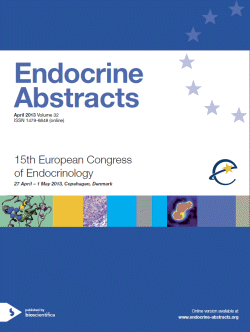Searchable abstracts of presentations at key conferences in endocrinology
Symposia
Male reproductive endocrinology
ea0032s12.1 | Male reproductive endocrinology | ECE2013
Semaphorin 3A: a new gene involved in Kallmann syndrome
Kallmann syndrome (KS) is a genetic disorder associating pubertal failure with congenital absent or impaired sense of smell. KS is related to defective neuronal development affecting both the migration of olfactory nerve endings and GnRH neurons. The discovery of several genetic mutations responsible for KS led to the identification of signaling pathways involved in these processes, but the mutations so far identified account for only 3040% of cases of KS. We attempted t...
ea0032s12.2 | Male reproductive endocrinology | ECE2013
Signal transduction in sperm functions
Mature spermatozoa acquire progressive motility only after ejaculation. Their journey in the female reproductive tract also includes suppression of progressive motility, reactivation, capacitation, and hyperactivation of motility (whiplash), the mechanisms of which are obscure. MAPKs are key regulatory enzymes in cell signaling, participating in diverse cellular functions such as growth, differentiation, stress, and apoptosis. We have reported that ERK1/2 and p38MAPK are prima...
ea0032s12.3 | Male reproductive endocrinology | ECE2013
Small RNAs in spermatogenesis
The protection of genetic integrity and establishment and maintenance of correct epigenetic marks are crucial in the germ line to prevent transmission of harmful information to next generations. Male germ cell differentiation is governed by accurate, spatially and temporally controlled gene expression patterns. Male germ cells produce several classes of small non-coding RNAs that are known to regulate gene expression at both post-transcriptional and transcriptional level. Thes...




